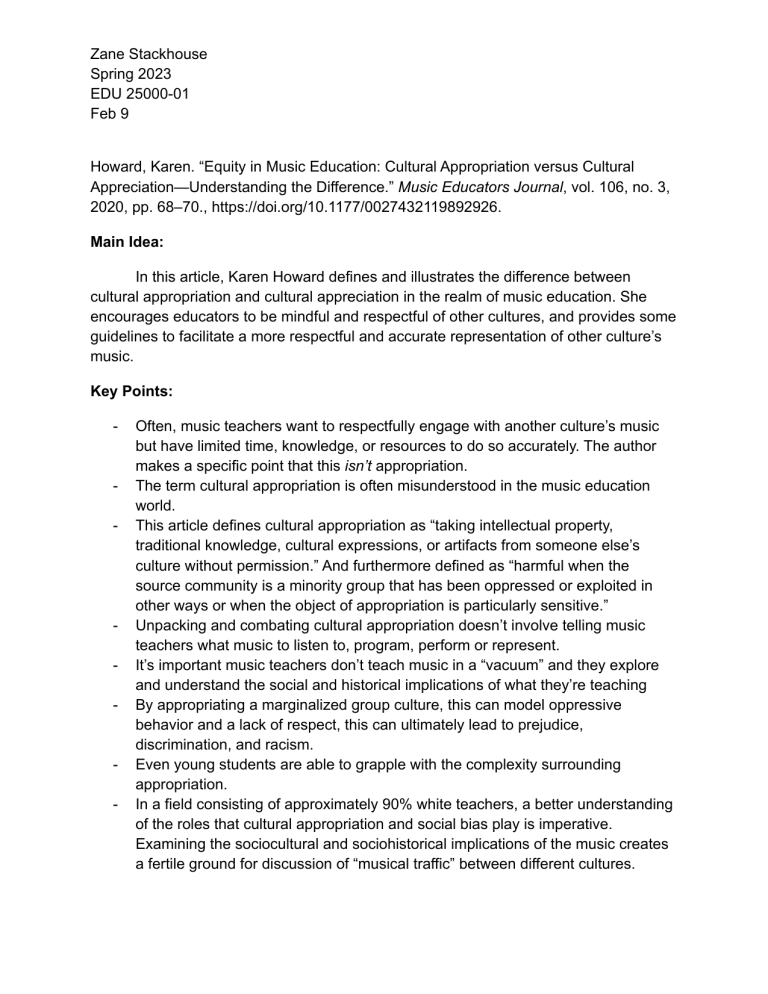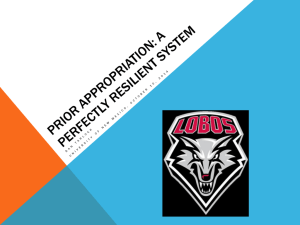
Zane Stackhouse Spring 2023 EDU 25000-01 Feb 9 Howard, Karen. “Equity in Music Education: Cultural Appropriation versus Cultural Appreciation—Understanding the Difference.” Music Educators Journal, vol. 106, no. 3, 2020, pp. 68–70., https://doi.org/10.1177/0027432119892926. Main Idea: In this article, Karen Howard defines and illustrates the difference between cultural appropriation and cultural appreciation in the realm of music education. She encourages educators to be mindful and respectful of other cultures, and provides some guidelines to facilitate a more respectful and accurate representation of other culture’s music. Key Points: - - - - Often, music teachers want to respectfully engage with another culture’s music but have limited time, knowledge, or resources to do so accurately. The author makes a specific point that this isn’t appropriation. The term cultural appropriation is often misunderstood in the music education world. This article defines cultural appropriation as “taking intellectual property, traditional knowledge, cultural expressions, or artifacts from someone else’s culture without permission.” And furthermore defined as “harmful when the source community is a minority group that has been oppressed or exploited in other ways or when the object of appropriation is particularly sensitive.” Unpacking and combating cultural appropriation doesn’t involve telling music teachers what music to listen to, program, perform or represent. It’s important music teachers don’t teach music in a “vacuum” and they explore and understand the social and historical implications of what they’re teaching By appropriating a marginalized group culture, this can model oppressive behavior and a lack of respect, this can ultimately lead to prejudice, discrimination, and racism. Even young students are able to grapple with the complexity surrounding appropriation. In a field consisting of approximately 90% white teachers, a better understanding of the roles that cultural appropriation and social bias play is imperative. Examining the sociocultural and sociohistorical implications of the music creates a fertile ground for discussion of “musical traffic” between different cultures. - Developing a “multicultural sensitivity” in yourself and your students is important and useful Multicultural sensitivity is defined as “desire or motivation to understand, appreciate, and accept the differences between diverse cultures.” When selecting repertoire to teach, there are a few important questions to consider. Some of these questions include “what is the plan for teaching/performing music from this particular culture?” “Is there an opportunity to work with/speak to an expert in particular cultural traditions who can advise and work with both the teacher and students?” and “Does the music teacher model for the students that the culture of origin is understood and respected?” Critical Analysis: I find Howard’s research article on cultural appropriation in relation to music education to be enlightening and informative. The foundational question that informs much of this article is “How can you share a wide variety of music and cultures with your students in a manner that respects and honors these traditions?” This can surely be a complex and multifaceted task to take on. Howard acknowledges the logistical challenges some educators face. She gave a few different examples that involve either a lack of time or knowledge on the subject matter. She specifically mentions how these aren’t examples of cultural appropriation in themselves, but if I am to critically analyze this article it seems some of these issues aren’t directly addressed in the article. For example, in one of the examples listed it depicts an elementary music teacher who wants to include songs related to the Mexican holiday Día de los Muertos, but simply doesn’t have the time to educate herself on the holiday given her busy schedule. I know this article is not an end-all-be-all about understanding cultural differences, it’s simply serving to bring awareness to this very real issue, but I was unable to find a direct solution in this article that addresses that particular issue. In Howard’s defense, it is a very complex and multi-faceted thing that is going to change depending on the culture you’re trying to represent. It would be nearly impossible to include solutions to every single issue you might come across when trying to accurately and respectfully perform music from any given culture. Howard is moreso offering a method of thinking, rather than an actual lesson plan or curriculum. She is urging educators to understand the intent behind what they’re teaching. Someone who clearly has respect and admiration for other cultures, and demonstrates what she referred to as “multicultural sensitivity,” will take the time to create a learning experience that engages diverse music and cultures in a respectful and accurate manner. This was one of my biggest take-aways from this article. If you’re going to use music or practices from another culture, take the time to understand the history and social context surrounding that music. Ask yourself, what is the plan for teaching this music and what is the story behind this music. Finding that story can be a process of discovery that can also involve your students. Consider if there’s an expert in that particular cultural tradition that you could work with (both for yourself, and your students.) Use empathy, consider how someone from that culture might feel about the representation and pedagogical approach to the music. If you use this method of thinking, you will be far more likely to be “appreciating” the culture instead of “appropriating” it. Summary: Overall, I found this article very illuminating and informative. This article serves as a methodology to teach a wide variety of music and cultures in a way that respects and honors those traditions. Howard gave clear and concise definitions of what cultural appropriation is and what it could look like in a music education setting. She encourages teachers to develop a “multicultural sensitivity,” and provides methods to disseminate that concept to their students. Finally, Howard provides a useful checklist to determine what kind of repertoire to select, and different methods and ideas that will help represent that culture in an accurate and respectful manner.

